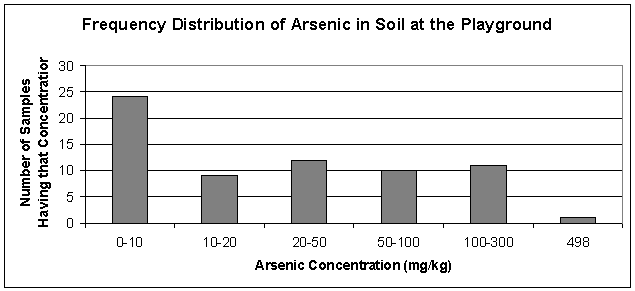PUBLIC HEALTH CONSULTATION
The Public Health Significance of Arsenic in Soil at the American University Child Development Center, Washington, DC
March 14, 2001
BACKGROUND
During World War I, the US Army conducted chemical warfare research at the American University and vicinity. Chemical weapons were detonated in several places during research and training. Chemical agents and weapons were also buried in the area. Since that time, the affected region has been developed; portions have been incorporated into the campus, and the rest is now residential.
The Army has identified a suspected disposal area on the western boundary of the American University. Because of concerns about potential soil contamination in the area, the Army sampled soils on the playground of a nearby daycare center, the American University Child Development Center (CDC). Initial sampling consisted of six samples, mixed together into a single composite sample. The Agency for Toxic Substances and Disease Registry (ATSDR) reviewed the results of the arsenic analysis of that sample, and found that it could be of concern should any children purposely swallow as much as a handful of dirt [1]. Since then, the Army has sampled the playground extensively, using a 10 foot grid to take samples. The results indicated elevated levels of arsenic in the soil. The CDC quickly moved to another facility, and remains there until the affected playground soil is removed and replaced.
ISSUES
The Army requested ATSDR to review new environmental sampling data from the CDC playground, to determine whether there is an increased risk of adverse health effects for the children and staff who worked and played at the CDC.
ENVIRONMENTAL DATA
The Army took 67 surface soil samples from the playground of the CDC, and analyzed them for arsenic. The average arsenic concentration in the samples was slightly less than 60 mg/kg, and the maximum was 498 mg/kg. Many of the samples had elevated arsenic levels. The distribution of arsenic levels is illustrated in the following figure.

HEALTH IMPLICATIONS
The American University Child Development Center serves children from ages 2½ to 6 years old. ATSDR estimates that children in this age group ingest around 200 mg of soil every day. Adults are estimated to ingest half this amount. Soils are ingested through several means, such as by eating with dirty hands, or placing dirty hands in the mouth. Soils may also be ingested as inhaled dusts, which are cleansed from the lungs and disposed of in the esophagus. Also, some very young children may purposely eat large amounts of soils.
There are several ways that children may have come into contact with the soils in the playground. There is a garden, where the children had direct contact with the soil. Children may also dig in the soil throughout the area. However, much of the playground is covered with a layer of mulch; the rest is covered with grass. The mulch and the grass probably limited the amount of contact the children had with the playground soils. The mulch and grass also limited the amount of dirt that could have become airborne and then inhaled.
In a different setting, where the children may have played directly in the soil every day, the arsenic levels that were found in the playground could be of health concern. However, the fact that the playground soil was covered with mulch and grass limited the children’s exposure. Also, we do not know how much of the arsenic that may have been swallowed passed through the gastrointestinal tract without being absorbed by the body. Because of these unknown factors, ATSDR required more information about how much arsenic the children were actually exposed to, before we could determine the significance of the arsenic levels.
To satisfy the need for additional exposure information, and at the request of the DC Department of Health, ATSDR undertook an Exposure Investigation at the American University CDC [2]. Hair was taken from 28 of the 30 children and from four staff at the school. Arsenic was detected in only eight of the 32 hair samples, not exceeding 0.14 ppm. This maximum value is within the normal range for unexposed people. The investigation concluded that hair arsenic levels were not elevated in any of the children or staff at the CDC [2].
CONCLUSIONS
Children and staff at the American University Child Development Center should not experience any adverse health effects from previous exposure to arsenic in soils at the playground.
RECOMMENDATIONS
ATSDR concurs with the Army that the soil arsenic levels in the affected areas of the CDC playground be reduced to normal background levels.
REFERENCES
- Agency for Toxic Substances and Disease Registry. “Assessment of Soil Sampling Results at the American University Child Development Center, Washington, DC,” Department of Health and Human Services, Atlanta, Georgia, December 14, 2000.
- Agency for Toxic Substances and Disease Registry. “Exposure Investigation, Spring Valley Chemical Munitions (a.k.a. American University Child Development Center).” Department of Health and Human Services, Atlanta, Georgia, March 8, 2001.
PREPARER OF REPORT
Dana Abouelnasr, Ph.D.
Senior Scientist, Office of Federal Programs
Agency for Toxic Substances and Disease Registry
phone: (404) 498-0684
toll free: 1-888-422-8737
email: DAbouelnasr@cdc.gov
- Page last reviewed: September 22, 2015
- Page last updated: December 31, 2001
- Content source:



 ShareCompartir
ShareCompartir